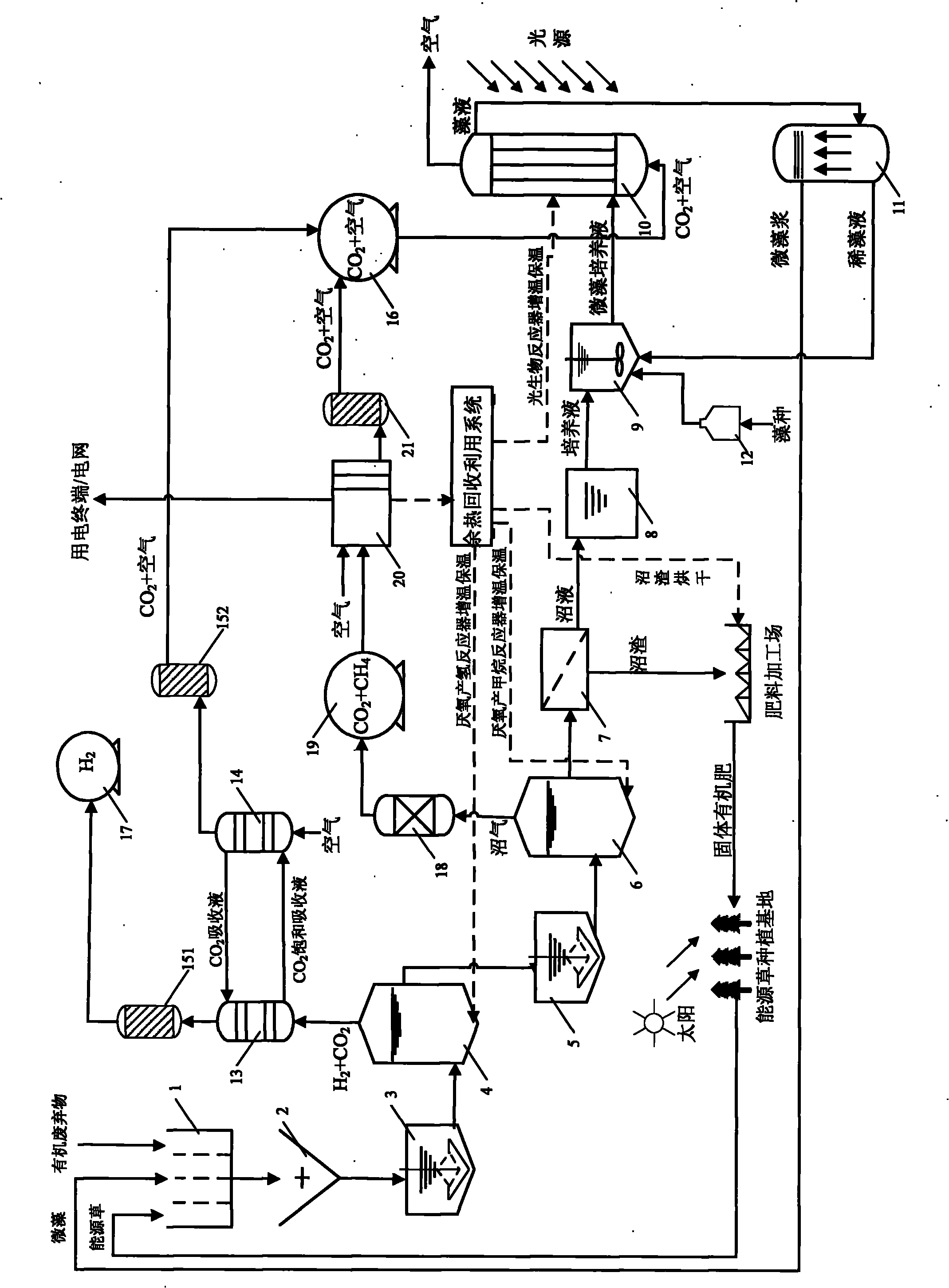Energy utilization method of carbon dioxide zero-emission type organic waste
A technology of organic waste and carbon dioxide, applied in the direction of fertilizers made from biological waste, organic fertilizers, waste fuels, etc., to achieve the effect of eliminating environmental pollution
- Summary
- Abstract
- Description
- Claims
- Application Information
AI Technical Summary
Problems solved by technology
Method used
Image
Examples
Embodiment 1
[0031] like figure 1 As shown, the organic waste in this embodiment is livestock and poultry manure (pig manure) and crop straw (rice straw), the pretreatment device is a straw crusher, the microalgae is heat-resistant chlorella (Chlorella sorokiniana), and the energy grass For hybrid pennisetum. The steps are as follows:
[0032] (1) Raw material collection and pretreatment: collect pig manure and rice straw respectively and store them in the raw material storage pool 1, and use the straw crusher 2 to crush the straw to a particle size ≤ 20mm;
[0033] (2) Anaerobic fermentation hydrogen production and hydrogen purification: collect anaerobic activated sludge from the biogas digester, heat it at 80°C for 60 minutes as the hydrogen production inoculum, and transfer the crushed straw and pig manure to the hydrogen production adjustment tank 3, according to Add hydrogen-producing inoculum to 20% of the total mass of straw and pig manure, and add water to adjust the total solid...
Embodiment 2
[0040] The steps of this embodiment are the same as those in Example 1, except that the organic waste is sludge (sewage treatment plant sludge) and domestic organic waste (fruit and vegetable waste), the microalgae is Chlorella kessleri, and the energy grass is elephant grass. and:
[0041] In step (2), the anaerobic activated sludge was heated at 100°C for 30 minutes as the hydrogen-producing inoculum, the total solids concentration (TS) of the mixed material was adjusted to 15%, the fermentation temperature of the hydrogen-producing fermentation was controlled to be 38°C, and the hydrogen-producing fermentation The time is 3 days; in step (3), the fermentation temperature is controlled to be 38°C, and the biogas fermentation time is 20 days; CO in air 2 The concentration is 20%, and the microalgae culture time is 3 weeks; in step (5), after 4 months of growth period, harvesting is carried out.
[0042] Applying the method of carbon dioxide zero-emission organic waste energ...
Embodiment 3
[0044] The steps of this embodiment are the same as those in Example 1, except that the organic waste is sludge (papermaking sludge) and domestic organic waste (kitchen waste), the microalgae is Chlorococcum littorale, and the energy grass is royal grass. and:
[0045] In step (2), the anaerobic activated sludge was heated at 115°C for 15 minutes as the hydrogen-producing inoculum, the total solids concentration (TS) of the mixed material was adjusted to 8%, the fermentation temperature of the hydrogen-producing fermentation was controlled to be 30°C, and the hydrogen-producing fermentation The time is 2 days; in step (3), the fermentation temperature is controlled to be 30°C, and the biogas fermentation time is 10 days; CO in air 2 The concentration is 40%, and the culture time of the microalgae is 2 weeks; in step (5), the harvest is carried out after 2 months of growth period.
[0046] Applying the method of carbon dioxide zero-emission organic waste energy utilization in...
PUM
 Login to View More
Login to View More Abstract
Description
Claims
Application Information
 Login to View More
Login to View More - R&D
- Intellectual Property
- Life Sciences
- Materials
- Tech Scout
- Unparalleled Data Quality
- Higher Quality Content
- 60% Fewer Hallucinations
Browse by: Latest US Patents, China's latest patents, Technical Efficacy Thesaurus, Application Domain, Technology Topic, Popular Technical Reports.
© 2025 PatSnap. All rights reserved.Legal|Privacy policy|Modern Slavery Act Transparency Statement|Sitemap|About US| Contact US: help@patsnap.com


